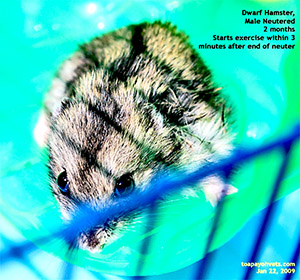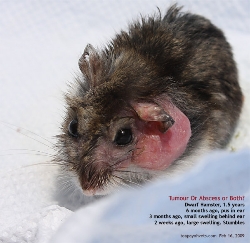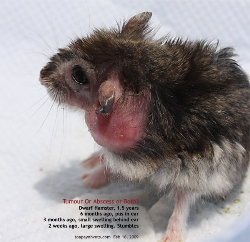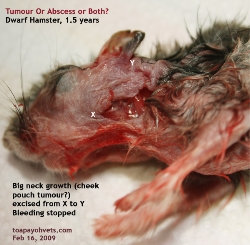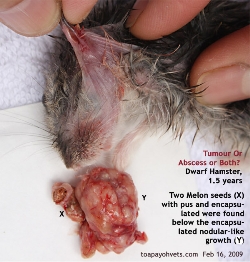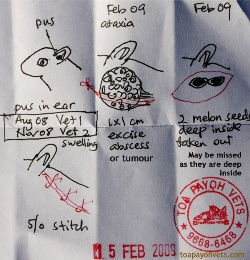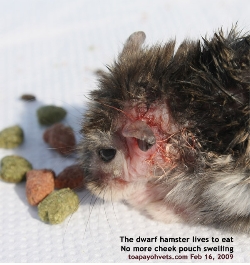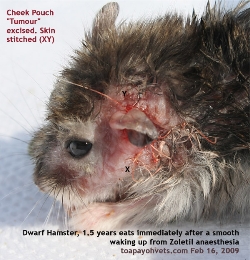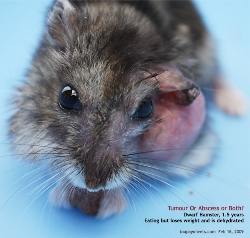
Moderately dehydrated as his skin stood up
when I pinched it. This dwarf hamster was
thin unlike the plump ones of his peers at
1.5 years. The young couple had
brought him in for treatment as he had
stumbled. That was due to the weight of the
massive growth to the side of his left
cheek. The growth was around 1 cm in
diameter and had extended to his left
shoulder blade. A hard lump that was
spherical in shape trying to rupture out of
his glistening pink skin that had become
paper thin. The skin was now hairless and
ready to rupture soon. The hamster still
ate. He lives to eat but he did not put on
weight.
Surgery was the only option. The hamster
needed to be pain free during surgery and
that meant anaesthesia. Anaesthesia kills
when the patient is not in excellent health.
The dosage must be sufficient so that the
cheek pouch growth could be removed without
the hamster feeling the pain. A bit more, he
would die. A bit less, he would be moving.
How much to give such that he would not die?
How about giving an I/V drip to combat the
dehydration. Well, this was not possible as
the hamster was too small. Subcutaneous
drip. Yes.
"You do understand that the hamster may die
on the operating table as your hamster is
not in good health, being thin and
dehydrated," I phoned the owner. "Yes," the
husband said. The wife had noted pus in the
left ear of the hamster some 6 months ago
and Vet 1 had cured him. Then 3 months ago,
Vet 2 told her that there was a swelling and
the hamster might need surgery to remove the
growth. Vet 2 was not confident of the
surgery. Now, the growth was massive and
fiery.
It was a firm nodular mass, more likely a
cheek pouch tumour or nodular abscesses now
hardened. Histopathology of the growth would
be useful but that cost money. I did not
propose doing histopathology as it would
increase the cost of treatment.
What if
this hamster die on the operating table?
This was a very challenging case. A patient
in poor health. A growth so large. Lots of
nerves in this area. If the nerves
were damaged during surgery, the hamster
might not be able to close his eyes eat
properly. His face might be paralysed. Such
a big growth would be supplied by a bigger
blood vessel and there would lots of
bleeding. The hamster could bleed to death
if the big vessel ruptured during removal of
the growth.
If this was a dog or cat, the surgery would
be so much easier as the anatomical
structures would be larger. Of course, dogs
and cats don't have cheek pouches unlike
hamsters but the operating areas would be
much bigger and easier to handle.
ANAESTHESIA
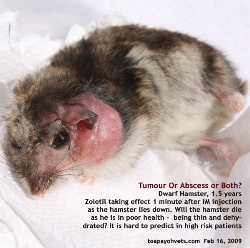 Zoletil 50 IM in a very low dose with
isoflurane gas to top up. The hamster could
not stand around one minute after the
Zoletil injection. He looked like he was
going to pass out. His eyes were open.
Zoletil 50 IM in a very low dose with
isoflurane gas to top up. The hamster could
not stand around one minute after the
Zoletil injection. He looked like he was
going to pass out. His eyes were open.
SURGERY
Clean the skin of the growth. Scalpel
cuts the skin. The ophthalmic sharp pointed
scissors undermine the skin to separate the
growth as one large mass without breaking it
up to pieces. Extended the incision to more
than 2 cm to get the tumour. So far so good.
No bleeding. The whole encapsulated nodular
growth was taken. A gush of red blood
spurted as the growth was excise. Artery
forceps clamped the source of the bleeding.
There was no defined blood vessels to ligate
and the hamster could bleed to death if a
major blood vessel was cut or damaged.
Bleeding stopped but the hamster's head
and legs were splattered with blood. I
cleaned up the blood.
5/0 absorbable sutures interrupted closed
the skin incision. The hamster was sleeping
throughout the surgery. Surgery needed to be
fast. Around 10 minutes. There was no
need for isoflurane gas anaesthesia top up
in this case.
The hamster looked dead for the next 2
minutes. Surgery was successful but the
owners only accepts one outcome - a live
hamster.
After 5
minutes, the hamster stirred and woke up as
if he had a nap. He ate. This is a hamster
that lives to eat. He went home on the same
day.
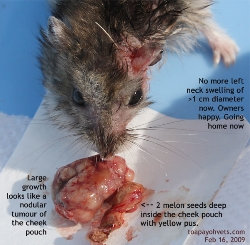 The
wife was joyful when she came to take the
hamster home. "She's the caregiver," the
husband said when I asked more about the
history as the hamster stayed overnight at
the Surgery as I was not on evening duty.
The
wife was joyful when she came to take the
hamster home. "She's the caregiver," the
husband said when I asked more about the
history as the hamster stayed overnight at
the Surgery as I was not on evening duty.
The hamster now had no large facial
swelling. He looked particularly handsome
with his sharp snout and big shiny black
eyes.
I showed the young couple the tumour and the
two abscessed melon seeds that I could
have missed after taking out the growth. I
don't expect two seeds pushed and hidden
deep in the recess of the wound. If I had
closed the skin wound, the hamster would not
have had recovered well. It is natural to
assume that the cheek pouch growth was the
sole cause of this spherical swelling. But
there were two melon seeds enclosed in part
of the cheek pouch. Trapped and forming
yellow pus.
The hamster wanted to eat the tumour but I
took it away quickly. He went home with
antibiotics. He is a hardy hamster. Living
day to day. He enjoyed eating and lives life
to the fullest.
HAMSTER OWNERS
Always get small tumours removed early.
It is not so easy to get a happy ending as
in this case. No animal can be expected to
survive anaesthesia when he is not in
excellent health. Even if he survives, he
may not live long as the stress of the
surgery and infection in a poor health
hamster kill him in the next few days.
VETS
Always check for other objects like seeds
once the cheek pouch growth is removed.
Life is full of surprises. The vet needs to
be more thorough in cheek pouch surgery and
look for seeds and other food impacted below
the growth! In this case, some
"superior powers" must have placed the two
melon seeds to test the thoroughness of the
vet. Are there such beings as
"superior powers"? Readers may disagree with
me. In any case, I was fortunate to spot the
seeds. The hamster would continue scratching
his left face and that would not be good for
him or the owner as the outcome was
unsatisfactory.
 TOA
PAYOH VETS
TOA
PAYOH VETS